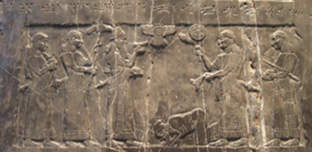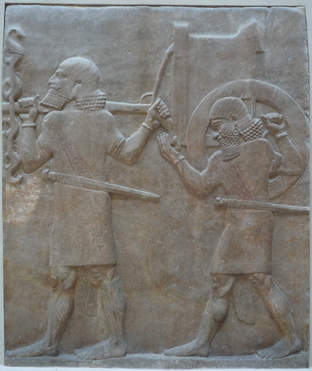Israel, the 'House of Omri'
The kingdom of Israel was known to the Assyrians after its founder as Bit-Humri, 'House of Omri'. Together with the kingdoms of Hamat and Damascus, it dominated the political landscape of Syro-Palestine in the 9th and 8th centuries BC and, like them, it eventually fell victim to the Assyrian expansion to the Mediterranean.
A bridge between the Mediterranean and the desert
Israel controlled the Mediterranean ports to the south of the Lebanon range and the rich agricultural lands between the coast and the river Jordan, a strategically and economically profitable position which provided a link between the route networks across the sea and the desert.

Israel's relations with Assyria oscillated between neutral, cordial and hostile. The submission of king Jehu before Shalmaneser III of Assyria (858-824 BC) is prominently depicted on one of the central panels of the so-called Black Obelisk, highlighting the importance of this alliance to Assyria. But before the reign of Tiglath-pileser III (744-727 BC), the nature of the relationship with Assyria was primarily defined by Israel's rapport with Damascus, its eastern neighbour and main rival in the region: frosty when in league with Damascus and close whenever the two were at odds.
Israel was directly affected when Assyria's western frontier was moved from the Euphrates to the Mediterranean coast and the Lebanon mountain range. The year 732 BC saw the first Assyrian invasion of Israel. This event is well documented in the Bible, albeit not from the viewpoint of Israel but of its southern neighbour, the kingdom of Judah. It is possible to juxtapose this narrative with passages in the royal inscriptions of Tiglath-pileser III which, although fragmentary, provide valuable insight into the Assyrian view on the matter.
The invasion of 732 BC according to the Bible
The Biblical account of the invasion of 732 BC differs from the Assyrian sources above all in the motivation identified as driving the Assyrian attack and conquest. According to the Bible, the invaders were brought to Israel by Ahaz, king of Judah, who asked Tiglath-pileser for a military intervention against Israel and Damascus:

"Ahaz sent messengers to say to Tiglath-pileser king of Assyria, 'I am your servant and vassal. Come up and save me out of the hand of the king of Aram (i.e. Damascus) and of the king of Israel, who are attacking me'. And Ahaz took silver and gold... and sent it as a gift to the king of Assyria. The king of Assyria complied." (2 Kings 16:7-9)
From a Judaean perspective, therefore, the Assyrian invasion of Israel was the direct consequence of Judah's vassal treaty with Assyria. In exchange for his loyalty and his tribute, king Ahaz was able to summon his overlord Tiglath-pileser who was bound by the treaty to protect his vassal against his enemies' aggression.
While not a single original treaty from the reigns of Tiglath-pileser III, Shalmaneser V (726-722 BC) or Sargon II (721-705 BC) has been recovered so far, the prescriptions of the extant treaties of their predecessors and successors demonstrate that the Biblical account describes the relationship between an Assyrian king and his client rulers accurately. For smaller states with aggressive neighbours, Assyria's commitment to give military assistance was of course the key appeal of entering into a vassal treaty.
... and according to Tiglath-pileser III
From an Assyrian perspective, however, the invasion of Israel was part of a much wider military offensive designed to establish political and economic dominance over the routes across the Syrian Desert to the harbours of the Mediterranean.
Tiglath-pileser's previous conquests in northern Syria (Arpad PGP in 740 BC, Unqu in 738 BC, northern parts of Hamat PGP in 738 BC) had resulted in an Assyrian corridor linking the Euphrates with the northernmost stretches of the east Mediterranean coast. This cut off Syro-Palestine from the important overland connection to Anatolia and caused an intensification of commercial, and consequently political, interests in Egypt and the Arabian peninsula.
But from an Assyrian point of view, the increased contacts with Egypt and the Arabs endangered its control over the region and therefore constituted high treason. Rahianu (Rezin) of Damascus and Peqah of Israel, who feature so prominently in the Bible as Judah's enemies, were among the treacherous vassals that also included Hiram of Tyre and Hanunu of Gaza (on the latter, see Philistia).

Assyria employed a strategy that was initially aimed at preventing any military intervention via Egypt where the powerful Kushites were increasingly gaining in influence. The conquest of Tyre and Gaza in 734 BC resulted in an Assyrian cordon of loyal vassals stretching from the Brook of Egypt to the eastern bank of the Jordan, blocking the land route into Egypt and also into Arabia. Judah, which is not at all mentioned in Tiglath-pileser's accounts, was one of these vassals. It must remain open whether its king Ahaz had allied himself with the Assyrians only in reaction to the capture of nearby Gaza or whether this had happened already before.
Thereafter, the war was thus confined to the north of modern Israel and what is today southwestern Syria. It culminated in the Assyrian siege of Damascus and the conquest of this great city in 732 BC. The annexation of the northern part of the kingdom of Israel followed. The events are related briefly in two passages of Tiglath-pileser's surviving inscriptions:
"The land Bit-Humri (= Israel), all of whose cities I had utterly devastated in my former campaigns, whose [people] and livestock I had carried off and whose (capital) city Samaria alone had been spared: (now) they overthrew Peqah, their king." (Tiglath-pileser III 44, 17-18)
"The land Bit-Humri (= Israel): I brought to Assyria [...], its auxiliary army, [...] and an assembly of its people. [They (or: I) killed] their king Peqah and I placed Hoshea [as king] over them." (Tiglath-pileser III 42, 15'b-17'a)
In 732 BC, the kingdom of Damascus lost its independence and existence, its holdings carved up into Assyrian provinces. Israel, on the other hand, was allowed to survive, albeit reduced to a fraction of its former size and cut off from the sea. Tiglath-pileser put it under the rule of a new king, Hoshea, chosen to serve as a loyal executor of Assyrian interests.
Israel's northern territories came under direct Assyrian rule. The newly established province of Megiddo centred around the city of the same name and included also the coastal regions with the harbour of Dor.
722 BC: the taking of Samaria
The north of the kingdom was lost, but as long as Hoshea proved himself a faithful Assyrian vassal the south remained independent. But during the reign of Shalmaneser V, the Assyrian army invaded the kingdom and conquered the city of Samaria. Because of the very limited range of available Assyrian sources for Shalmaneser's reign, the reconstruction of the events depends largely on Biblical evidence and details are unclear and debated. According to the Bible, Shalmaneser attacked Israel after Hoshea had sought an alliance with "So, king of Egypt", possibly Osorkon IV of Tanis, and it took the Assyrians three years to take Samaria (2 Kings 17).

It was the standard practice of the time to incorporate enemy troops into the conquering forces but after decades of absorbing defeated armies, the Assyrians only extended this privilege to a chosen few. A hand-selected 200 (later versions: 50) chariot crews of the famous Samaritan chariot corps made the cut according to the inscriptions of Sargon II; the remainder of the troops were discharged. A number of administrative documents excavated in Kalhu demonstrate that the Samaritan chariot corps was subsequently stationed in that city. Very unusually, it was allowed to retain its group identity and organisational structure. This must be due to its specialised expertise which provide a valuable addition to the existing array of Assyrian battle techniques.
Already in the 9th century, the Israelites emerge from the Assyrian sources as master charioteers. They used heavily fortified, tank-like chariots which were drawn by a particularly large breed of horses originating from Kush (Nubia). The Samaritan chariot corps introduced these vehicles and horses to the Assyrian army and, over the following decades, their use and strategic importance increased markedly so that by the 7th century, it was no longer associated exclusively with the chariot crews of Samaria.
The lost tribes of Israel
Just like in 732 BC, substantial parts of the Israelite population were resettled elsewhere in the Assyrian Empire after the fall of Samaria in 722 BC. They are the "lost tribes of Israel" of the Bible:
"The king of Assyria captured Samaria and deported the Israelites to Assyria. He settled them in Halah (Assyrian Halahhu PGP ), in Gozan (Assyrian Guzana PGP ) on the Habur River and in the towns of the Medes PGP ." (2 Kings 17:6)
Halahhu lies in central Assyria: it is the territory that came to constitute the province of Sargon's new capital city of Dur-Šarruken. The Israelite presence in Guzana, in what is today northeastern Syria, is confirmed by 7th century texts such as the letter SAA 16 63, featuring persons whose names invoke the god Yahwe. The cities of the Medes under Assyrian control are situated in three provinces in the Zagros mountain range: Parsua PGP , Harhar PGP and Kišessim. If one assumes that the Israelites were resettled immediately, then Parsua is the only option as the other two provinces were only established in 716 BC.
Samaria itself became the centre of a new Assyrian province which is attested in several letters of Sargon's state correspondence (SAA 1 220, SAA 1 255, SAA 5 291 and SAA 15 280). The Assyrian conquest of southern Palestine continued when Ashdod was defeated in 711 BC. This Philistine city became the centre of the most southern of Assyria's provinces on the Mediterranean coast. The kingdom of Judah, however, remained independent and proved a loyal ally to Assyria until the death of Sargon II.
Further reading:
Archer, 'Chariotry to cavalry', 2010.
Dubovský, 'Tiglath-pileser III's campaigns in 734-732 B.C.', 2006.
Na'aman, 'Tiglath-pileser III's campaigns against Tyre and Israel', 1995.
Tadmor, 'The Inscriptions of Tiglath-pileser III', 1994.
Content last modified: 5 Nov 2012.
Karen Radner
Karen Radner, 'Israel, the 'House of Omri'', Assyrian empire builders, University College London, 2012 [http://www.ucl.ac.uk/sargon/essentials/countries/israel/]